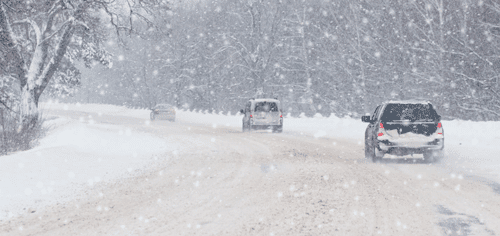- Need Any Help: +1 647-760-5505 or
- info@trubicars.ca
Going for your driving test is such an exciting time, but it can also be a nervous time, especially if the weather is not ideal during your driving test. Being prepared for the expected and the unexpected can help you succeed with your goal of getting your driver’s license. If you’re attempting your G2 test or the G test, being prepared to handle the wintery conditions on the driving test day will help to ensure you are ready during winter weather.
One of the first things to do is get as much experience driving on snowy and icy roads as you can. There are things you can do before your driving test, especially if this is your first time driving in those conditions.

The common fear many people may have is having a lack of traction, so with that in mind, here’s what you should do to gain experience and confidence driving in these conditions before you go for your driving test.
Before you begin driving in wintery conditions, one of the first things to do is to convince the vehicle owner to put winter tires on the vehicle if they haven’t already. Winter tires have a wider tread than all-season tires, and the rubber is softer than regular all-season tires. If you’re going for your driving test in the winter, these tires can help you keep traction.
In a quiet area with snow on the ground, stop your vehicle with no one around you and once you’re ready, apply the accelerator quickly and listen to the sound coming from the spinning tires. Once you hear the wheels spin, ease off the gas and gently stop the vehicle again. Then, apply the gas again gently, without the wheels spinning. This will allow you to know exactly how much pressure it takes to press the gas on snowy roads to help you maintain traction. This helps to increase your winter driving confidence.
Next, you want to do something similar with your braking. On a quiet, snow-covered road, travel approximately 20 km/h, and when there is no one behind you, apply the brakes quickly and very hard. Listen to the sound the anti-lock brakes make so you can understand what they sound like if you press the brake pedal too hard. This way, it won’t startle you. Now, get up to 20 km/h and brake again but with less pressure to learn how smoothly it takes to brake under control. The confidence you will gain while driving on snowy or icy roads comes with practice and knowing what you can and cannot do.
Adjusting to the road conditions to keep your traction and staying in your lane when there is a lot of snow on the road can be challenging. Reading the road conditions to see the tracks the other vehicles have made on the road can help to provide some traction for your vehicle as you travel down the road. It’s a lot easier to break on bare pavement, so if that is available, try keeping your tires in those tracks to help you do so. If the road is snow-covered, you should brake earlier than on bare pavement. The reason is to give your tires a chance to grip the road surface.
The road conditions near stop signs can turn icy and make stopping more difficult. A thin layer of freshly fallen snow may hide some of the icy sections of the road. If the road surface appears to be somewhat shiny, chances are the snow has turned icy. If this happens, move out of the tracks toward a snowy section. This will make braking a little easier for you and help you to avoid sliding into the intersection. That position would also make it easier to accelerate gently after stopping without your wheels spinning, or not spinning very much.
Keeping a safe following distance is helpful at any time of year, but more so when the road conditions are snowy, slushy, or icy. It would be a good idea to add another 2 seconds to your already 3-second following distance when the road is slippery. This will give you additional time to brake gradually when the driver ahead hits their brakes hard. This added distance and a gentler braking technique will give the driver behind a better chance to stop safely.
One of the slippery road surfaces is a condition we cannot see. When the pavement looks like new asphalt or looks dark and wet could most likely be covered in ice. Black ice is commonly found on top of bridges and in shaded areas, such as where the road is covered with thick trees, and will generally form after temperatures drop and recent precipitation. The best way to treat this black ice is to maintain your speed as much as possible and avoid sudden changes to your steering. Ignoring this may cause your vehicle to slide or skid.
Considering that most vehicles on the market now are front-wheel drive – meaning the front wheels pull the vehicle along – if your vehicle does begin to skid, do your best to remain calm and do the following:
If the vehicle continues to skid, you may need to abandon the turn and go around the block.
Having control of your vehicle during your driving test will show the driving examiner you are ready to pass and drive alone. Learning how to handle your vehicle and make changes to your driving techniques is helpful during any winter driving especially on your driving test. Let Trubicars help you prepare for your road test, including in the challenging winter season!

 February 13, 2024 by
February 13, 2024 by Reema Sharma
Reema Sharma
 January 17, 2024 by
January 17, 2024 by Trubicars
Trubicars
 January 17, 2024 by
January 17, 2024 by Trubicars
Trubicars
Once you acquire the knowledge provided in
those tests, you are ready to pass the
test,
the first time.
